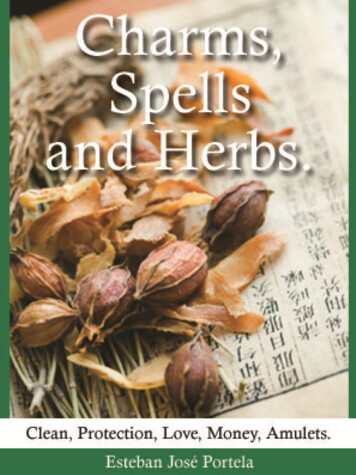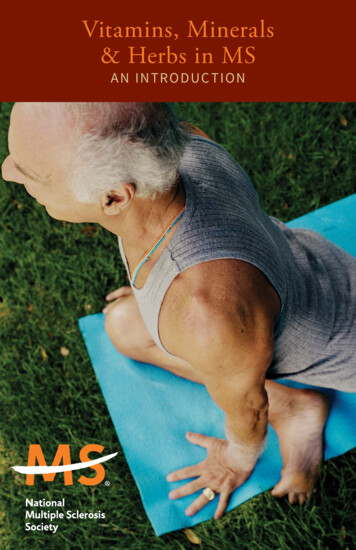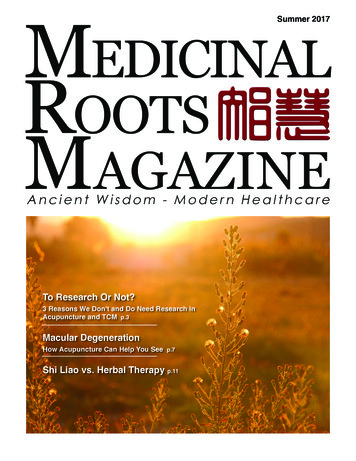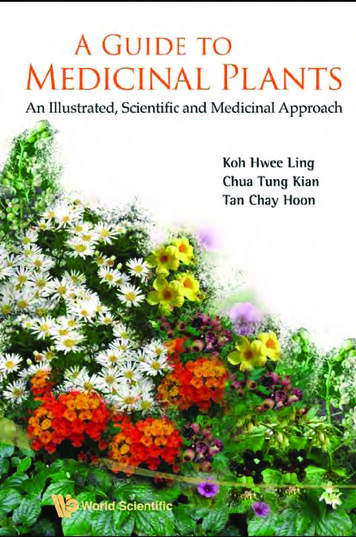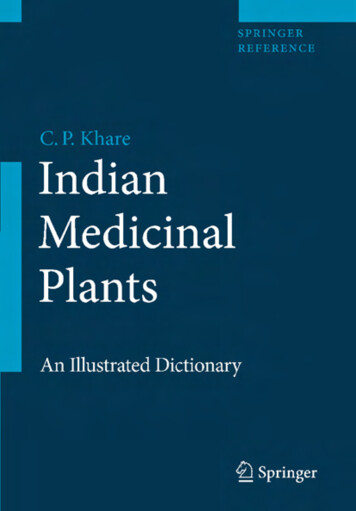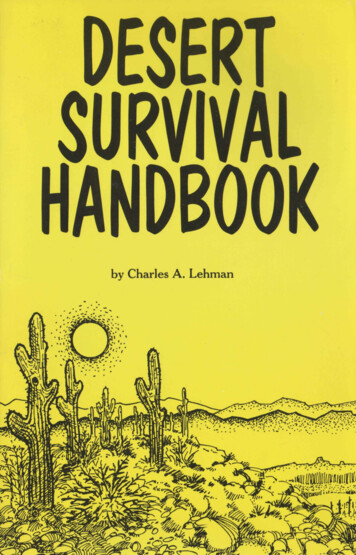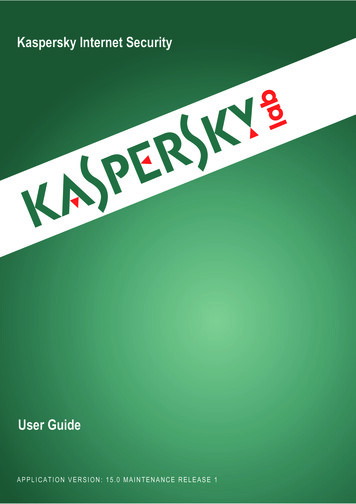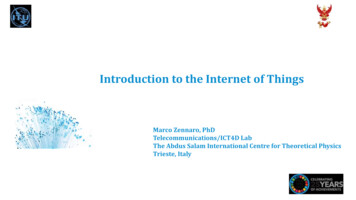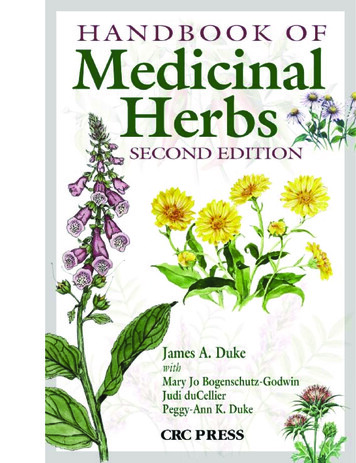
Transcription
HANDBOOK OFMedicinalHerbsSECOND EDITION
1284 frame FM Page 2 Thursday, May 23, 2002 10:53 AM
HANDBOOK OFMedicinalHerbsSECOND EDITIONJames A. DukewithMary Jo Bogenschutz-GodwinJudi duCellierPeggy-Ann K. DukeCRC PR E S SBoca Raton London New York Washington, D.C.
Peggy-Ann K. Duke has the copyright to all black and white line and color illustrations.The author would like to express thanks to Nature’s Herbs for the color slides presented in the book.Library of Congress Cataloging-in-Publication DataDuke, James A., 1929Handbook of medicinal herbs / James A. Duke, with Mary Jo Bogenschutz-Godwin,Judi duCellier, Peggy-Ann K. Duke.-- 2nd ed.p. cm.Previously published: CRC handbook of medicinal herbs.Includes bibliographical references and index.ISBN 0-8493-1284-1 (alk. paper)1. Medicinal plants. 2. Herbs. 3. Herbals. 4. Traditional medicine. 5. Material medica,Vegetable. I. Duke, James A., 1929- CRC handbook of medicinal herbs. II. Title.[DNLM: 1. Medicine, Herbal. 2. Plants, Medicinal.]QK99.A1 D83 20022002017548615′.321--dc21This book contains information obtained from authentic and highly regarded sources. Reprinted material is quoted withpermission, and sources are indicated. A wide variety of references are listed. Reasonable efforts have been made to publishreliable data and information, but the author and the publisher cannot assume responsibility for the validity of all materialsor for the consequences of their use.Neither this book nor any part may be reproduced or transmitted in any form or by any means, electronic or mechanical,including photocopying, microfilming, and recording, or by any information storage or retrieval system, without priorpermission in writing from the publisher.The consent of CRC Press LLC does not extend to copying for general distribution, for promotion, for creating new works,or for resale. Specific permission must be obtained in writing from CRC Press LLC for such copying.Direct all inquiries to CRC Press LLC, 2000 N.W. Corporate Blvd., Boca Raton, Florida 33431.Trademark Notice: Product or corporate names may be trademarks or registered trademarks, and are used only foridentification and explanation, without intent to infringe.Visit the CRC Press Web site at www.crcpress.com 2002 by CRC Press LLCNo claim to original U.S. Government worksInternational Standard Book Number 0-8493-1284-1Library of Congress Card Number 2002017548Printed in the United States of America 1 2 3 4 5 6 7 8 9 0Printed on acid-free paper
IntroductionBy the time this second edition is published, the first edition of the Handbook of Medicinal Herbswill have been out more than 15 years. The second edition is designed to present most of the oldinformation plus new information on the more important of those original 365 herbs. I submittedthe first edition under the original unpublished title, Herbs of Dubious Salubrity. I intentionally leftout many of the completely safe culinary herbs, spices, and food plants that are clearly medicinal.I also intentionally omitted some strictly dangerous herbs, such as foxglove, that were too unhealthyfor use in unskilled hands. I did include several obscure hallucinogenic plants of dubious salubrity.I did, or should have, dropped some of these because they have little medicinal importance. Somepoorly documented species, such as Mimosa hostilis and Phoradendron leucarpum, for example,were retained with fragmentary entries, so as to at least mention species from the first edition thatmight better have been dropped.Now I think I have the most important herbs well covered here. In edition two, which I willrefer to frequently as my Herbal Desk Reference (HDR), I have tried to concisely corral the dataon some 1000 herbs in as little space as possible, striving to make a reliable, referenced resourceto parallel the PDR for Herbal Medicines. I use the three-letter abbreviation, HDR, to indicate thesecond edition of my Handbook of Medicinal Herbs, because I compare and contrast it to otherimportant sources, which are also represented by three-letter abbreviations. (See the referenceabbreviation appendix.)With this edition, I have tried to cover most of the widely mentioned medicinal plants, whetherthey are extremely salubrious or extremely toxic. Without counting them, I estimate we includemore than 1000 of the most important herbs, including the more important herbs from the youngNative American and the European traditions (including most of those approved by CommissionE (KOM), and almost all of those included in the PDR for Herbal Medicine (PHR for the firstedition, and PH2 for the second edition). Unlike Commission E and the Herbal PDR, which seemto stress European and American traditions, I include proportionately more herbs from the olderAfrican, Ayurvedic, and Chinese traditions as well, not wanting to slight any major medicinal plantfrom any major tradition.Let me explain the new format for the second edition. First, a common name appears, usuallybut not always in English, followed by a recently accepted scientific name, with the authority forthe scientific name. Then follows a safety score, X, , , or . An X means I don’t recommendtaking it at all, or realize that it is so dangerous that it should not be taken without expert guidance.But for litigious reasons, I give some potent medicinal herbs the X (amateurs beware!). A singleplus ( ) indicates that I do not consider that the herb is, overall, as safe as coffee. I score twopluses ( ) for those herbs I think of, overall, as being as safe as coffee. I score three pluses ( )for those herbs I believe to be safer than coffee. In the first edition, I related the plus sign to a cupof coffee, figuring that 1, 2, or 3 cups per day of an herbal tea from the herb would be as safe as1, 2, or 3 cups per day of coffee. I often drink more than 3 cups of coffee a day, especially whileI worked on this project! Clearly, this is an oversimplification. Too often, some parts of a plant aremore helpful or more toxic than other parts of the same species, and different ethnic groups orcultures may use parts differently. The safety scoring is a continuation of the same scoring systemI used in the first edition. Some scores have been upgraded a bit, some have been downgraded.Often, there are some comments on synonymy and other nomenclature difficulties that arosein completing this opus. I inject these following the nomenclature line. Here you may find someproven and/or suspected synonyms, or notes of related species that may be included in this species
concept, especially by nontaxonomically trained authors. I have often used, as final arbiter ofscientific names and sometimes common names, the nomenclature database at the USDA (www.arsgrin.gov; curator, Dr. John. H. Wiersema: sbmljw@ars-grin.gov).Unfortunately, the new American Herbal Products Association (AHP) book on nomenclaturearrived too late for our consideration. Attempts to standardize common names, although admirable,are often aggravating to special interests. It was with some misgiving that I arranged this bookalphabetically by common names, when the first edition was by scientific name. It generated bigheadaches for all of us who think more along the lines of scientific names. Would it be undermulberry or black mulberry, chamomile or German chamomile? Some plants have dozens ofcommon names. Several have suffered almost as many scientific names, such as, for example,feverfew. Hopefully, you will find it easy to use.In the Activities and Indications sections, parenthetical numbers are followed by three-letterabbreviations (abbreviation of source) or an alphanumeric X-1111111 to identify PubMed citations.A parenthetical efficacy score of (1) means that a chemical in the plant or in an extract of the planthas shown the activity or proven out experimentally (animal, not clinical) for the indication. Thiscould be in vitro animal or assay experiments. A hint: not real human proof! Nothing clinical yet!I give it a score of (2) if the aqueous extract, ethanolic extract, or decoction or tea derived fromthe plant has been shown to have the activity, or to support the indication in clinical trials.Commission E (KOM) and Tramil Commission (TRA) approvals were automatically given a scoreof (2) also, because they represented consensus opinions of distinguished panels. The rare scoreof (3) for efficacy means that clinical trials exist to show that the plant itself (not just an extractor phytochemical derivative) has the indications or activities. The solitary score of (f) in many ofthe citations means it is unsupported folk medicine, or I have not seen the science to back it up.The three-letter abbreviations are useful short citations of the references consulted in arriving atthese numbers. I have by no means cited every source. However, unlike KOM and hopefully betterthan PHR, we indicate at least one source for every indication and activity we report.Thus, we have a score for Safety and a score for Efficacy, the latter backed up by the threeletter abbreviations or citations, often PubMed citations. In addition to our three letter abbreviationsfor the frequently consulted texts, we occasionally cite articles cited from the PubMed databasewith their unique abstract number, preceded by the letter X. For example, I received a paper showingthat ginger contained several COX-2 inhibitors. I looked in the PubMed database to find the uniqueabstract citation number, PMID: 11437391, which I shortened for database purpose to X11437391.So, all alpha-numeric (X-numerical) combinations will refer you to the source in the PubMeddatabase. Whenever I update one of my Herb-a-Day columns, I automatically search PubMed for species name AND 2000 , which automatically gives me the post 1999 abstracts. In 2001, Isearch for species AND 2001 . Then I order hard copies of those articles that look promising fordatabase purposes.Often, many more than 10 sources were involved in my decision-making. In many instances,I limited citations to three, typically the ones that were most important at arriving at my scores.Not wanting to blow my own horn, my own books were first to be deleted from the list when itexceeded three. In preparing this edition I realized that for patent litigation, the earlier citationswere most valuable, so at the last minute I added several older references, such as DEP, FEL, HHB,and MAD. For example, even I was surprised when I read about Remifemin in HHB (1973, p. 12),three decades ago, since Remifemin seems so new here in America. But in my mind it is justanother native American remedy, coming back home to us, slightly upgraded, after having beenbetter studied in Europe than it has been in America (other examples include evening primrose,passionflower, and saw palmetto). DEP and FEL citations are more than 100 years old, and mightbe useful in challenging frivolous patents.One very important abbreviation, WAM, might as well be viewed as MOM, meaning pediatric.This comes from the excellent book, Kids, Herbs, Health, by Dr. Linda White, MD, and Sunny
Mavor. So, if you are looking for an herb that has been suggested by a pediatrician, scroll downto WAM. Ditto for PIP, Hans Schilcher’s Phytotherapy in Paediatrics.This is an evolving system that changes as new science validates the folklore, often resultingin an upgrading of the indication or activity. Occasionally, bad news about the plant will result inmy lowering its safety rating, from to , or to , or to X. This does not constitute myrecommendation of an herb. It merely indicates how I think the herb compares with others, basedon the literature surveyed. As a botanist, I cannot legally, and do not, prescribe. But I find mechanicalsearches of the Handbook of Medicinal Herbs to be an extremely fast way to find the better herbsfor a given indication.We have used the same abbreviations that are used in my database at the USDA (http://www.arsgrin.gov/duke). I much prefer the abbreviations used there because they do not get you into asmuch trouble when you e-mail a query to the taxpaying public. For example, the preferred abbreviation of microgram, at least with some publishers (including CRC), but not me, is µg. Too often,if I put that abbreviation (or use an italicized u) in an e-mail, the u or µ disappears and the readerreceives g instead of ug or µg, giving an often dangerously high reading, a million times too high.Ditto for ul or µl (microliter) as opposed to ml (milliliter). And with uM and mM, micromole andmillimole, respectively.In a sense, my scored second edition is a loner’s approach to a Commission E, but I am the solemember of the fictitious commission, Commission U.S. for us, here in the good old USA. Note thatunlike the ratings in, for example, APA, my ratings assess the efficacy of each activity and indication.I’ll keep revising the scoring for an online version as new information, positive or negative,comes in on the safety or efficacy of the herb, or chemicals it contains. So, like the allopaths, healthannouncers, and reporters, I reserve the right to change my mind as I oscillate from side to sideof the pendulum on my long, tedious, treacherous, and tumultuous trip, veering like a coiledcaduceus, deviously toward the truth.Users will find it easy to search and find which herbs score highest for efficacy and safety. Thethree-letter abbreviations will lead them to some, but by no means all, of the sources I consultedincluding the one(s) or some of them that led me to the numerical scores for efficacy. The scoresare my own. Only rarely did all the cited and consulted sources agree; but one of the indicatedsources provided the evidence that led me to arrive at the assigned score. By no means shouldthese scores be attributed to anyone except me.THE APA RATINGSA warning: my highest ratings are my best ratings. With the American Pharmaceutical Association(APA) and the American Herbal Products Association (AHP), the converse is true: the higher thenumber, the lower the rating. APA’s best, (1), is verified by large clinical, randomized, placebocontrolled, double-blind, human trials. That too would have gotten approval, we assume, in Commission E. That would get a (2) in my HDR, if the study were of an extract of the plant, but a (3) forexample if the study were of the natural whole herb, such as garlic or onion. The APA (1) and theHDR (3) scores are rare indeed. Their number (1) means “Years of use and extensive, high-qualitystudies indicate that this substance is very effective and safe when used in recommended amountsfor the indication(s) noted in the ‘Will It Work For You?’ section.” Unfortunately, they often mentionunapproved, unstudied folklore in this section, even clearly noting that it was unapproved. With APA,(2) is a large, clinical human trial, but not necessarily double blind and placebo controlled. That wouldalso get a (2) in my HDR, if the study were of an extract of the plant, but a (3) if the study were ofthe whole herb, rather than the extract. And the third one is hard for me to believe, but here is thequote, “large, placebo-controlled animal experiment.” That would get a (1) in my HDR. The APA (4)is for in vitro studies, which I suppose includes studies, e.g., of isolated phytochemicals. Those score(1) in HDR. The APA (5) is for decades or centuries of well-known folk use, but no supporting studies.That would get an (f) for folkloric in the HDR. APA (6) is a large collection of case histories, which
would also get an (f) in HDR. At the bottom of the APA ladder is the personal anecdote, which ofcourse, also gets an (f), even though it has not yet evolved into folklore.THE AHPA CLASSIFICATIONA few specific comments regarding the American Herbal Products Association (AHP). Although Ilike the way they handled some perplexing little details, such as idiosyncratic allergies, trivialquantities of toxic substances, etc., I’m a little alarmed by their ‘Class 1’ definition. Why alarmed?Because I feel that all drugs, whether they be synthetic, phytochemical, nutritional, or herbal, “canbe safely consumed when used appropriately.”Class 1: Can be safely consumed if used appropriately.Class 2: Herbs with the following use restrictions apply; unless otherwise directed by anexpert qualified in the use of the substance:(2a) External use only(2b) Not for use in pregnancy(2c) Not for use while nursing(2d) Other restrictions as notedClass 3: Herbs with significant data suggesting labeling: “To be used only under the supervision of an expert qualified in the appropriate use of this substance.” Labeling mustinclude proper use information: dosage, contraindications, potential adverse effects anddrug interactions, and other information pertinent to the safe use of the substance.Class 4: Herbs with data insufficient for classification.Why don’t I like that ‘Class 1’ definition? My interpretation of ‘Class 1’ definition is thatall herbs are ‘Class 1’ and can be safely used if used appropriately (appropriate is safe). Similarly,I think we could say appropriately for many, if not most, herbs what AHPA says of labelinginformation that should be required for aloe, “Do not use this product if you have abdominalpain or diarrhea. Consult a health care provider prior to use if you are pregnant or nursing.Discontinue use in the event of diarrhea or watery stools. Do not exceed recommended dose.Not for long term use.” (AHP, 1997)A subset of American phytomedicine advocates argue that we should emulate the GermanCommission E’s Standard of Excellence. Which one? Two versions came out in 1998, purportingto be authentic English presentations of the Commission E conclusions. There were some differences; e.g., Blumenthal’s very careful book (identified as KOM in this book) states that hyssop isunapproved by Commission E, while Gruenwald, in the second edition of the PDR for HerbalMedicine, says hyssop is approved for colds, fevers, and gallbladder and liver complaints. In thetitle line, where I evaluate safety, I scored hyssop with three pluses ( ), meaning that I think itis safer than coffee as an herbal medicine. As to efficacy, I had decided to let Commission Eendorsement rank 2 in my Activities and Indications columns.This example of divergence between the published “Commission E” interpretations ofhyssop (and there are more than ten English interpretations of Commission E now) is just oneof many that I encountered as I traversed most of these interpretations. It really raises a seriousquestion again that I raised for myself back in the early 1980s as I was working on my MedicinalPlants of China. Clearly, I was capable of working only with the English translations of Chinesebooks on medicinal plants, embellished by three trips to China. I assumed that by the time Ihad compiled most of the information from five different books, there would be little newinformation as I traversed the sixth. But diminishing returns had not yet set in. There are a fewmajor discrepancies in recent translations of romance language, scientific German, as withCommission E. How many more can we expect in translations of ancient Chinese, Hindu, and
Sanscrit writings that are thousands of years old? Small wonder we often encounter differencesof opinion.One can only be thankful that these books have survived because they document millenniaof empirical wisdom. The best of the herbal medicines have survived and the worst have beenmarginalized. That took thousands of years. You can almost say the same of pharmaceuticals:some have survived, while some of the worst have been marginalized or withdrawn. But noneof the pharmaceuticals have survived more than 200 years with us. But the 140 herbsmentioned in the Bible have been with us 2000 years. A recent study showed that humanshave been active in the Biblical area for at least 1,700,000 years. So, the genes of some humanshave experienced many of the phytochemicals from Biblical plants for nearly
scientific names and sometimes common names, the nomenclature database at the USDA (www.ars-grin.gov; curator, Dr. John. H. Wiersema: sbmljw@ars-grin.gov). Unfortunately, the new American Herbal Products Association (AHP) book on nomenclature arrived too late for our consideration.
